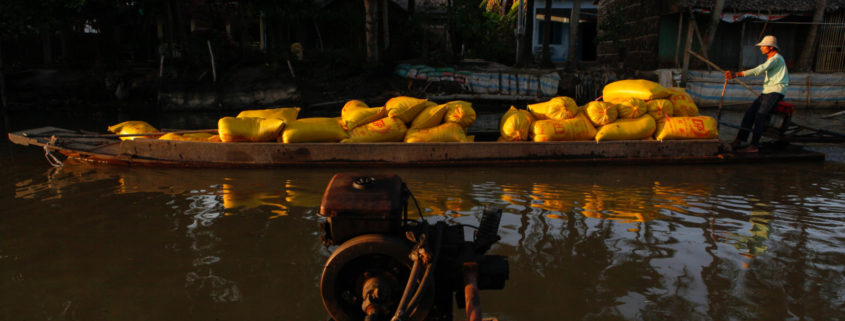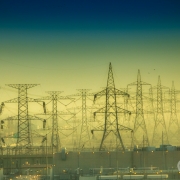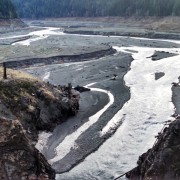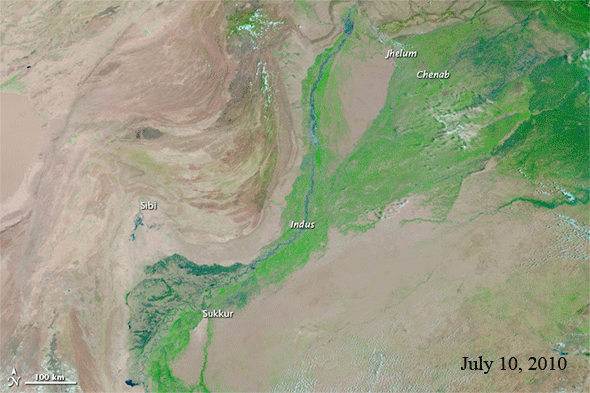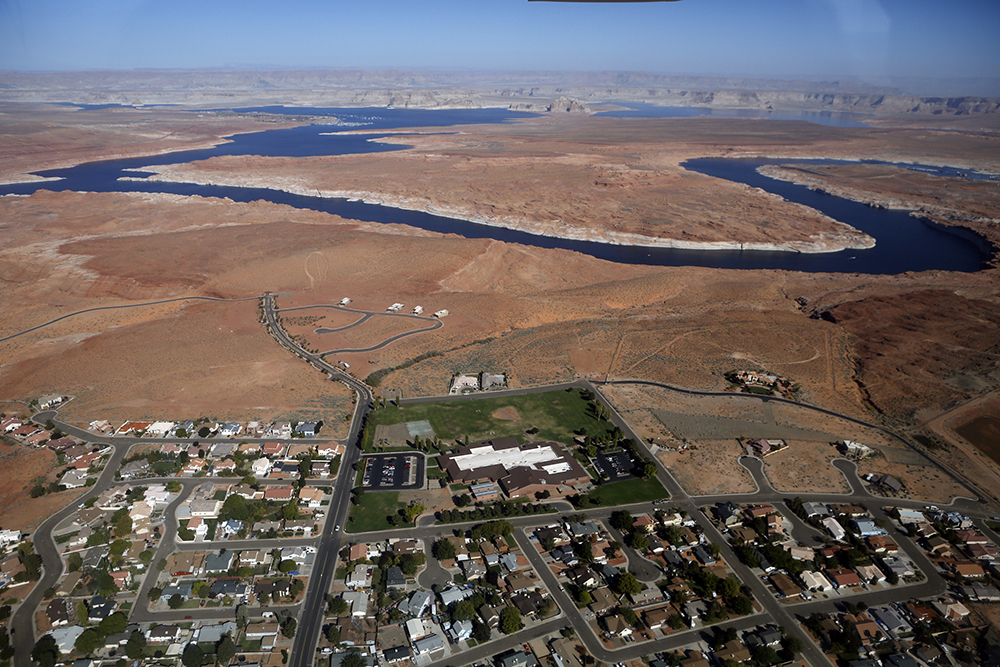One By One Big Hydropower Dams Disrupt Mekong River’s Free Flow
In unfolding global energy revolution, expensive and ecologically risky dams may not be right choice to generate more electricity.
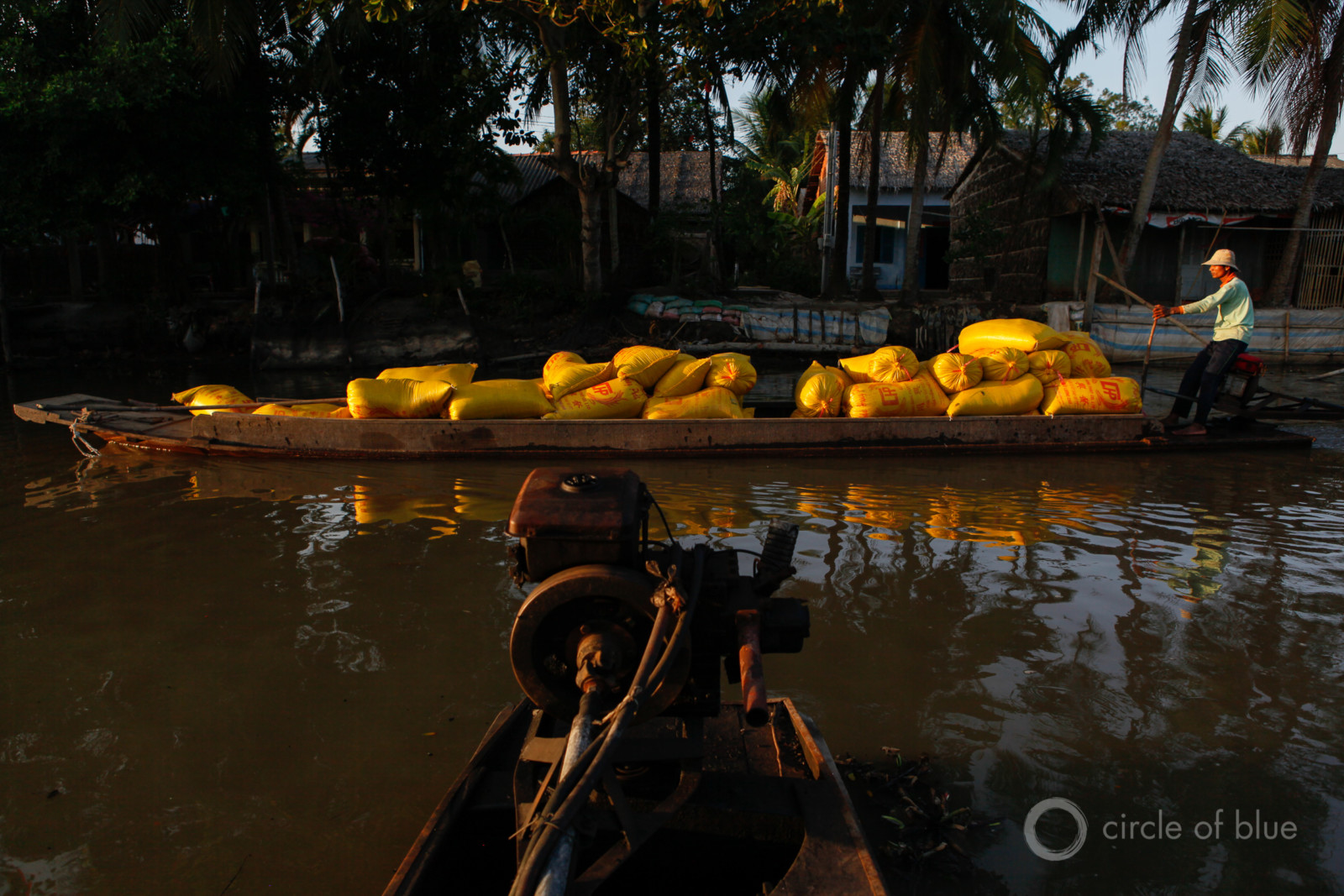
Plans by Laos to build big hydropower dams on the Mekong River are seen by many villagers, the region’s environmental organizations, and some officials in neighboring countries as making a mockery of the river’s natural beauty and its central value as a source of fish, irrigation, and commerce. Photo © J. Carl Ganter / Circle of Blue
By Keith Schneider, Circle of Blue
The bend in the Mekong River where Laotian authorities want to build the Pak Beng hydropower dam is described as one of the most beautiful stretches along all of the 4,000-kilometer (2700-mile) river. High bluffs tower above farm fields and tropical forests. Fishing villages lie along the shoreline. The deep and dark waters teem with fish and birds soar above the shallows.
Laos’ plan to build the 912-megawatt, $2.3 billion dam is a step in one of the world’s most aggressive hydropower development programs. The tiny landlocked nation of 7.1 million people is setting out to build 350 hydropower projects and add 26,000 megawatts (26 gigawatts) to the 6,300 megawatts of electrical generating capacity that Laos currently produces from its 39 operating hydropower dams. Along with the Pak Beng dam, two are under construction downstream, and three more are planned to cross the Mekong River.
“The Department of Energy has the ambitious plan to raise the electrification ratio to 95 percent of families across the country,” Xaypaseuth Phomsoupha, a director general in the Laos Ministry of Energy and Mines, told an international water and hydropower conference last year. “This plan is amongst the priorities of the government to eradicate poverty in the country.”
It is also a plan that is seen by many villagers, the region’s environmental organizations, and some officials in neighboring countries as making a mockery of the Mekong’s natural beauty and its central value as a source of fish, irrigation, and businesses that better fit conditions of the 21st century. On the bend of the Mekong designated for the Pak Beng dam and along other big bends upstream in China, and downstream in Laos and Cambodia, one of the world’s great river basins is steadily being hemmed in, and not just by dams.
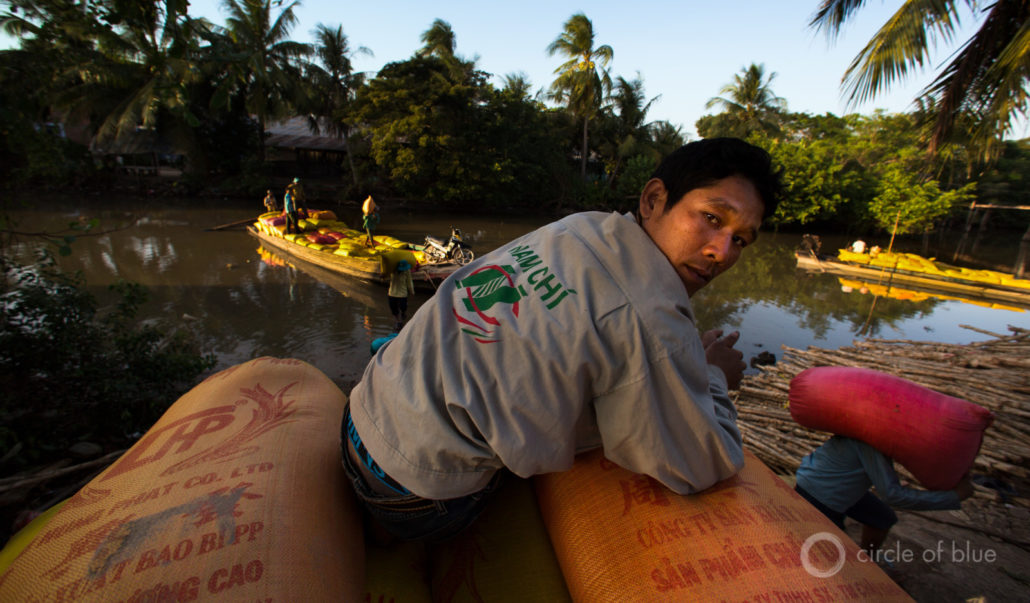
The Mekong River’s regular cycles of low water during dry seasons and floods during monsoons influence the lives of people in six nations that count on the river for food and their livelihoods. Photo © J. Carl Ganter / Circle of Blue
The Mekong and a good number of the more than 60 million people in four Southeast Asia nations that rely on the river are being pushed around by what they view as obsolete electrical generating priorities. With surprising speed, Southeast Asia has emerged as the latest testing ground for competing theories about the scale and expense of relying on water for electrical energy. The 20th century idea of building immense and expensive hydropower dams is rushing headlong into a wave of less expensive and less disruptive alternative energy technologies and development.
Boiled down, the issues are globally momentous. On one side are long-standing practices in project financing, engineering, and economic development theories about the usefulness of big hydropower dams. On the other side are cleaner and less costly generating technologies, civic opposition to big dams, and erratic water supplies caused by climate change that make managing dams much less certain. The outcome will decide how much of the Mekong and the last untouched stretches of the other great rivers in Asia, Africa, and South America will continue to flow freely.
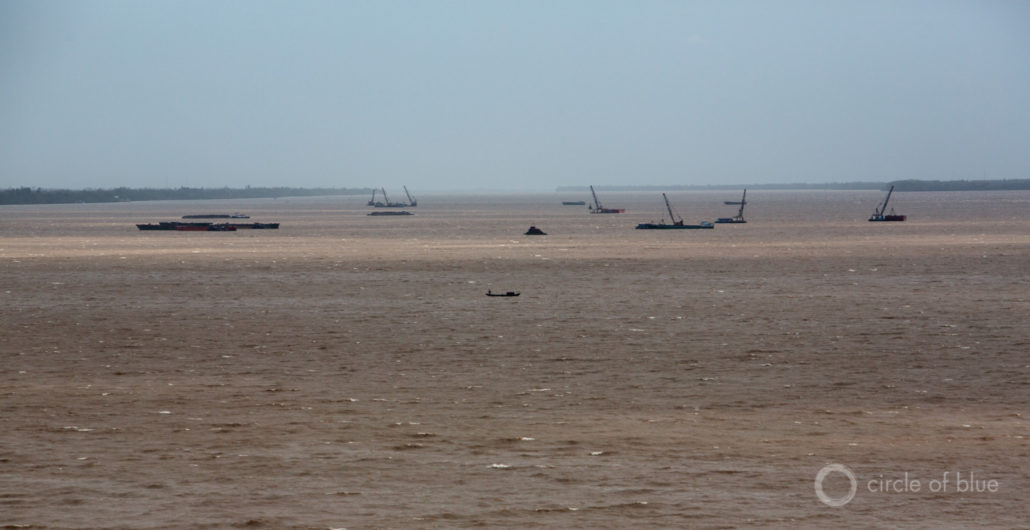
Along big bends upstream in China and downstream in Laos and Cambodia, the Mekong River is steadily being hemmed in by hydropower dams. Photo © J. Carl Ganter / Circle of Blue
“The energy revolution is evolving around the world,” said Carl Middleton, an assistant professor of political science at Chulalongkorn University in Bangkok, and a scholar on Mekong River development. “This region is resisting the shift, though, because of the economics of building big new projects. But it seems inevitable that the shift will happen here. It raises questions about continuing to build so many big dams.”
A Big and Important River
Historically, from its source on the Tibetan plateau, the undammed Mekong gathered water and energy as it flowed through China, Myanmar, Laos, and Thailand before dropping its rich silt and sediment in a rice-growing delta in Vietnam. The Mekong Basin’s water supported one of the world’s largest freshwater fisheries. Its regular cycles of low water during dry seasons and flooding during monsoons influence the lives of people in five nations that count on the river for food and their livelihoods.
Historic texts reveal that constructing big Mekong Basin hydropower dams dates to the early 1950s. The Bureau of Reclamation, the water supply manager for the U.S. Department of the Interior, recommended extending its dam building prowess to the region. The idea faded in the conflicts that engulfed Southeast Asia over the following 30 years.
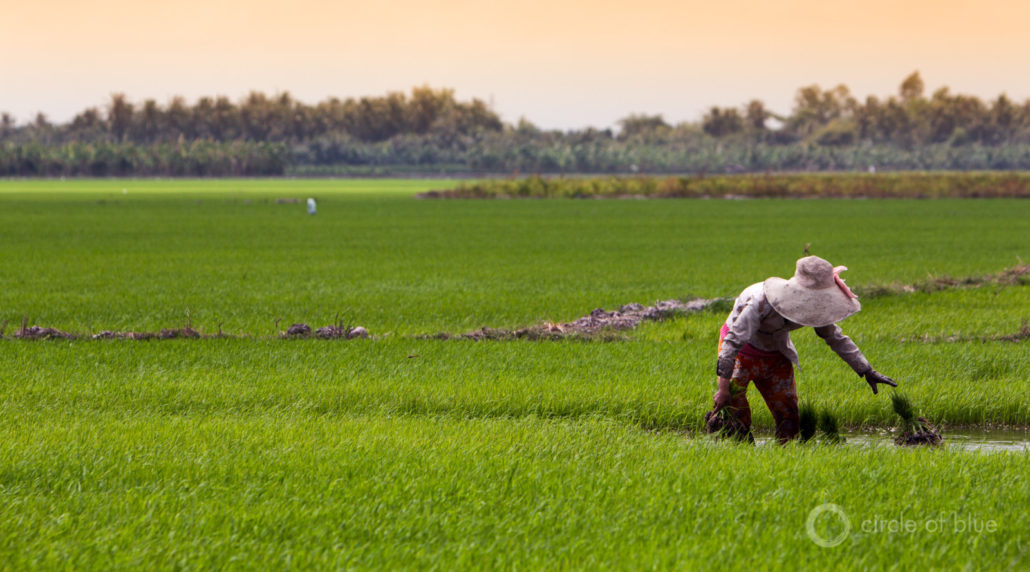
Historically, from its source on the Tibetan plateau, the undammed Mekong gathered water and energy as it flowed 4,000-kilometers (2,700 miles) through China, Myanmar, Laos, Thailand, and Cambodia before dropping its rich silt and sediment in a rice-growing delta in Vietnam. Photo © J. Carl Ganter / Circle of Blue
By the mid-1990s China had replaced the United States as the leading dam-building nation, and the Mekong became one of its principal targets. The Mekong’s natural water flows began to change when China built the first of six big hydropower dams in the river’s upstream reaches. In 1995, recognizing the value of the Mekong’s waters to their wellbeing, Thailand, Cambodia, Laos, and Vietnam formed the Mekong River Commission, a research and planning organization. The four countries formed a pact and a process to consult each other and reach agreement on constructing big dams.
There are 286 river basins in the world that encompass boundaries of multiple countries, according to the Institute for Water and Watersheds at Oregon State University. The Mekong River Commission is one of 121 transboundary river organizations in the world. The commission’s research divisions, regarded as highly competent internationally, have published incisive findings about the largely deleterious effects that dam building will have on water flow, fisheries, and farming communities.
Moratoriums and Alternatives
Last year Cambodia announced a moratorium on new dam construction until at least 2020 based on public opposition and the damage it projected to the Mekong and tributaries in its jurisdiction. Cambodia is nearing completion of the 400-megawatt, $816 million Lower Sesan 2 hydropower dam on the Sesan River, a Mekong tributary. The project unleashed a furor in river communities, which are convinced it will ruin a prime freshwater fishery, a finding supported by commission studies. More than 5,000 people are being forced to move from the 30,000 hectares (74,000 acres) of forest and farmland that will be flooded by the dam’s big backwater lake.
Not nearly as effective has been the Mekong River Commission’s prior consultation mandate. Laos has been particularly impassioned about its authority to do what it wants within its borders. Along with the Pak Beng project Laos has started construction on two more Mekong River hydro dams — the $3.8 billion, 1,260-megawatt Xyaburi and the $600 million, 260-megawatt Don Sahong hydropower dams.
Both dams lie at the center of an intensifying discussion about energy production, human rights, sovereign authority, and ecological sustainability. Laos authorities assert that its river development program is a sound and safe way to build its economy. It can generate electricity for domestic markets and also sell power to its neighbors.
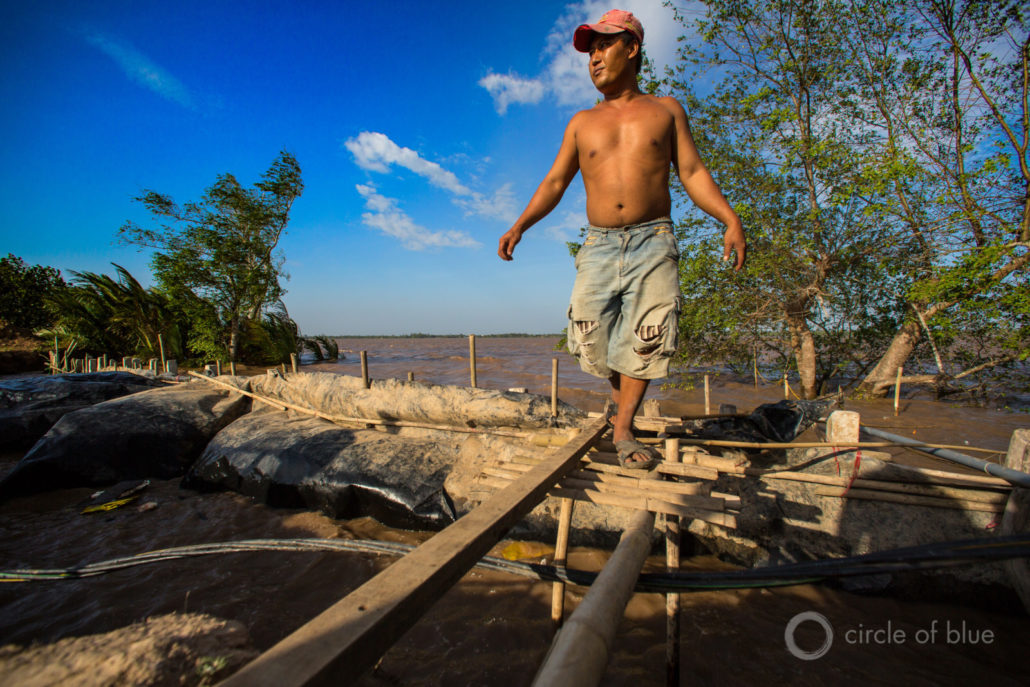
A good number of the more than 60 million people in four Southeast Asian nations that rely on the Mekong River are being pushed around by what they view as obsolete electrical generating priorities. Photo © J. Carl Ganter / Circle of Blue
Laos’ hydro dam development plans are backed by extensive international financing, particularly by Chinese investors. Viraphonh Viravong, the deputy minister of energy and mines and the principal government advocate for hydropower, said he is intent on making his country the “Kuwait of hydropower of Southeast Asia.”
Citizens affected by construction plans, though, are reacting with intensifying influence. Mekong Eye, an online news organization that reports on the region, features probing original articles about human hardship in Mekong villages caused by construction and planning.
Another operating challenge is climate change. The region’s shifting meteorology is changing the basin’s water supply patterns and causing engineers and power specialists to adjust their power production and revenue estimates. The problem is particularly acute for “run-of-the-river” projects that have no backwater storage reservoirs. Big hydropower dams, say engineers, are not nearly as reliable as they once were for generating power and profits.
Some of that message is infiltrating, particularly in Vietnam, which built hydro dams that deliver a third of the nation’s 40 gigawatts of electrical generating capacity, according to the U.S. Energy Information Administration. But Vietnam has developed about 80 percent of its hydropower potential and is leery about coal-fired power plants.
Following the lead of China and India, Vietnam is attracting substantial international investment capital to develop renewable energy projects, according to the General Department of Energy. Binh Thuan Province, for instance, has encouraged investors to develop 20 renewable energy projects. The largest is a 200-megawatt solar plant. Solar and wind generating prices are now less than the cost of building coal-fired power plants and very competitive with constructing big hydropower projects. Other Vietnamese provinces are developing wind and solar projects to raise renewable energy to at least 10 percent of the country’s generating capacity by 2030, anticipated to be over 100 gigawatts.
Circle of Blue’s senior editor and chief correspondent based in Traverse City, Michigan. He has reported on the contest for energy, food, and water in the era of climate change from six continents. Contact
Keith Schneider

